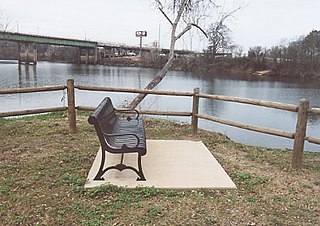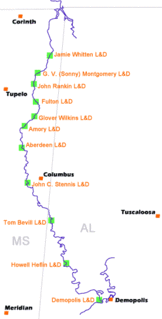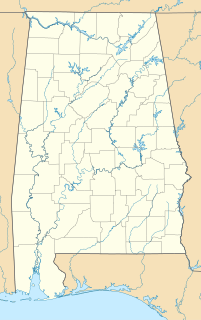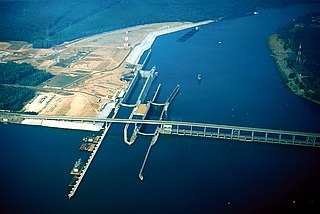
Tishomingo County is a county located in the northeast corner of the U.S. state of Mississippi. As of the 2010 census, the population was 19,593. Its county seat is Iuka.

The Tennessee River is the largest tributary of the Ohio River. It is approximately 652 miles (1,049 km) long and is located in the southeastern United States in the Tennessee Valley. The river was once popularly known as the Cherokee River, among other names, as many of the Cherokee had their territory along its banks, especially in eastern Tennessee and northern Alabama. Its current name is derived from the Cherokee village Tanasi.

The Tombigbee River is a tributary of the Mobile River, approximately 200 mi (325 km) long, in the U.S. states of Mississippi and Alabama. Together with the Alabama, it merges to form the short Mobile River before the latter empties into Mobile Bay on the Gulf of Mexico. The Tombigbee watershed encompasses much of the rural coastal plain of western Alabama and northeastern Mississippi, flowing generally southward. The river provides one of the principal routes of commercial navigation in the southern United States, as it is navigable along much of its length through locks and connected in its upper reaches to the Tennessee River via the Tennessee-Tombigbee Waterway.

The Mobile River is located in southern Alabama in the United States. Formed out of the confluence of the Tombigbee and Alabama rivers, the approximately 45-mile-long (72 km) river drains an area of 44,000 square miles (110,000 km2) of Alabama, with a watershed extending into Mississippi, Georgia, and Tennessee. Its drainage basin is the fourth-largest of primary stream drainage basins entirely in the United States. The river has historically provided the principal navigational access for Alabama. Since construction of the Tennessee-Tombigbee Waterway, it also provides an alternative route into the Ohio River watershed.

The Black Warrior River is a waterway in west-central Alabama in the southeastern United States. The river rises in the extreme southern edges of the Appalachian Highlands and flows 178 miles (286 km) to the Tombigbee River, of which the Black Warrior is the primary tributary. The river is named after the Mississippian paramount chief Tuskaloosa, whose name meant 'Black Warrior' in Muskogean. The Black Warrior is impounded along nearly its entire course by a series of locks and dams to form a chain of reservoirs that not only provide a path for an inland waterway, but also yield hydroelectric power, drinking water, and industrial water.

Howell Thomas Heflin was an American lawyer and politician who served in the United States Senate representing Alabama from 1979 to 1997. He chose not to run for reelection in 1996.

The Tennessee–Tombigbee Waterway is a 234-mile (377 km) man-made waterway that extends from the Tennessee River to the junction of the Black Warrior-Tombigbee River system near Demopolis, Alabama, United States. The Tennessee–Tombigbee Waterway links commercial navigation from the nation's midsection to the Gulf of Mexico. The major features of the waterway are ten locks and dams, a 175-foot-deep (53 m) cut between the Tombigbee River watershed and the Tennessee River watershed, and 234 miles (377 km) of navigation channels. The ten locks are 9 by 110 by 600 feet, the same dimension as the locks on the Mississippi above Lock and Dam 26 at Alton, Illinois. Under construction for twelve years by the U.S. Army Corps of Engineers, the Tennessee–Tombigbee Waterway was completed in December 1984 at a total cost of nearly $2 billion.
Columbus Lake is a lake in northeast Mississippi on the Tennessee-Tombigbee Waterway. Close to Columbus, it is impounded by the John C. Stennis Lock and Dam.

The John C. Stennis Lock and Dam, formerly named Columbus Lock and Dam, is one of four lock and dam structures on the Tennessee-Tombigbee Waterway that generally lie along the original course of the Tombigbee River. It is located near Columbus, Mississippi, and impounds Columbus Lake. It is named for longtime U.S. Senator from Mississippi, John C. Stennis.

The Aberdeen Lock and Dam is one of four lock and dam structures on the Tennessee-Tombigbee Waterway that generally lie along the original course of the Tombigbee River. It is located east of Aberdeen in Monroe County, Mississippi and impounds Aberdeen Lake.

The Tom Bevill Lock and Dam, formerly named Aliceville Lock and Dam and "Memphis Lock and Dam", is one of four lock and dam structures on the Tennessee-Tombigbee Waterway that generally lie along the original course of the Tombigbee River. It is located near Aliceville, Alabama and impounds Aliceville Lake. It is named for Tom Bevill, a proponent of the Tenn-Tom.

Aliceville Lake is a reservoir in western Alabama and eastern Mississippi, on the Tennessee-Tombigbee Waterway. Close to Aliceville, it is impounded by the Tom Bevill Lock and Dam.
Gainesville Lake is a reservoir in northwest Alabama on the Tennessee-Tombigbee Waterway. Close to Gainesville, it is impounded by the Howell Heflin Lock and Dam.

The Amory Lock is a lock and dam on the Tennessee-Tombigbee Waterway.

The Fulton Lock is a lock and dam on the Tennessee-Tombigbee Waterway.

The Jamie Whitten Lock and Dam is part of the Tennessee-Tombigbee Waterway. It is located in south Tishomingo County, Mississippi, United States, close to the Prentiss County line.

Pickwick Lake is the reservoir created by Pickwick Landing Dam as part of the Tennessee Valley Authority. The lake stretches from Pickwick Landing Dam to Wilson Dam.

Bay Springs Lake is a reservoir on the Tennessee-Tombigbee Waterway in the U.S. state of Mississippi. It is impounded by the Jamie Whitten Lock and Dam. The lake is approximately nine miles long, between waterway mile markers 412 at the dam, and 421 near the entrance to the divide cut.
Bashi Creek, also historically known as Bashai Creek, is a tributary of the Tombigbee River in northern Clarke County in Alabama.

The 1962 United States Senate election in Alabama was held on November 6, 1962 to elect one of Alabama's members to the United States Senate. Incumbent Democratic U.S. Senator J. Lister Hill won re-election to his fifth, and last, full term.
















